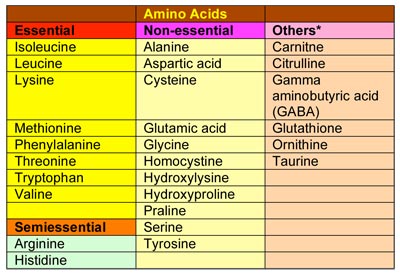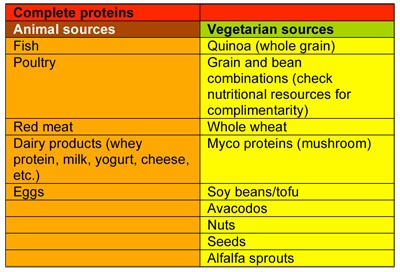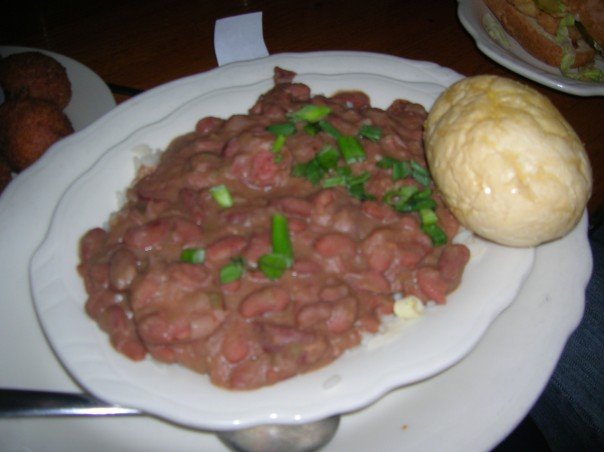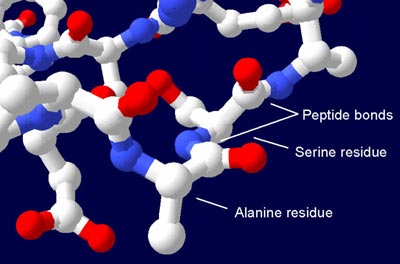Learn
Proteins are complex molecules comprised of a combination of some of the twenty-eight currently known naturally occurring amino acids. Each protein has a unique amino acid sequence and three-dimensional structure and exist as long chains, branched molecules, spheres or helixes (as with DNA). The L-forms of each amino acid are those found naturally in proteins, while the D-form — which can be synthesized but are not part of body proteins— are the mirror images of the naturally occurring ones. Of these naturally occurring amino acids, twenty main L-form amino acids and a few other minor ones are required to build all body proteins.
Diagram of a protein molecule showing the peptide bonds between amino acids
![]()
Essential amino acids are those that our body cannot synthesize and must be acquired through our diet. These eight essential amino acids are:
- isoleucine
- leucine
- lysine
- methionine
- phenylalanine
- threonine
- tryptophan
- valine
There are twelve primary non-essential amino acids, plus another eight minor non-essential which we will not discuss in this section. These non-essential amino acids can be manufactured by the body and/or obtained through the diet.

*These are not found in body tissue structure, but contribute to human metabolism.
![]()
A complete protein is one that contains all eight essential amino acids:

An incomplete protein is a one that contain less than all eight amino acids:

Protein Complimentarity
 When two incomplete protein foods are eaten together to create a complete protein, it is called protein complimentarity. It is also important to note that there is a cellular storage pool that the body can access if necessary. This allows some time to pass before an incomplete protein diet begins to have negative ramifications, as well as to allow protein complimentarity to happen over the course of several meals.
When two incomplete protein foods are eaten together to create a complete protein, it is called protein complimentarity. It is also important to note that there is a cellular storage pool that the body can access if necessary. This allows some time to pass before an incomplete protein diet begins to have negative ramifications, as well as to allow protein complimentarity to happen over the course of several meals.
A great example of protein complimentarity is combining grains and beans to create a complete protein meal. A common combination would be brown rice and kidney beans. A person eating a diet consistently deficient in complete proteins will eventually incur a protein deficiency disease symptomatic of the specific missing protein.

Protein Function
Building Blocks for Tissue: Proteins are the main building blocks for tissues including muscle, hair, nails, skin, eyes, internal organs, nerves, ligaments, tendons, cartilage, and membranes. They are also the building blocks of cells, cellular membranes, and organelles--all the way to the level of DNA and genes.
Metabolic Functions: Amino acids come together in thousands of combinations. Each combination can also arrange itself into many possible shapes. This creates virtually unlimited possible types of protein molecules. These proteins are used in many ways to communicate different types of information throughout the body. For instance, they are used as a kind of memory in the immune system: antibodies are formed to remember an invading organism so an immune response will be ready for the next possible encounter.
Calories per Gram: Like carbohydrates, proteins have 4 calories per gram. You can use the simple formula below to calculate calories.
Grams protein × 4 = calories
![]()
Read Nutrition for Everyone — Protein, Overconsumption and Underconsumption of Protein, and Biological Value chart. Look for these keys as you read:
- What are the protein requirements for your age group?
- What are the effects of too much protein?
- What are the effects of a protein deficiency?
- What protein source has the highest BV (biological value)?
